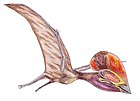| Lingyuanopterus Temporal range: | |
|---|---|
 | |
| Holotype of Lingyuanopterus (IVPP V 17940) with a peipiaosteid fish above | |
| Scientific classification | |
| Domain: | Eukaryota |
| Kingdom: | Animalia |
| Phylum: | Chordata |
| Order: | † Pterosauria |
| Suborder: | † Pterodactyloidea |
| Family: | † Istiodactylidae |
| Genus: | † Lingyuanopterus Xu et al., 2022 |
| Type species | |
| †Lingyuanopterus camposi Xu et al., 2022 | |
Lingyuanopterus (lit. ' Lingyuan wing') is a genus of istiodactylid pterosaur from the Aptian age Jiufotang Formation in western Liaoning, China. The type and only species is L. camposi, known from the holotype specimen IVPP V 17940 a near complete skull, mandible and atlas-axis complex. [1]













